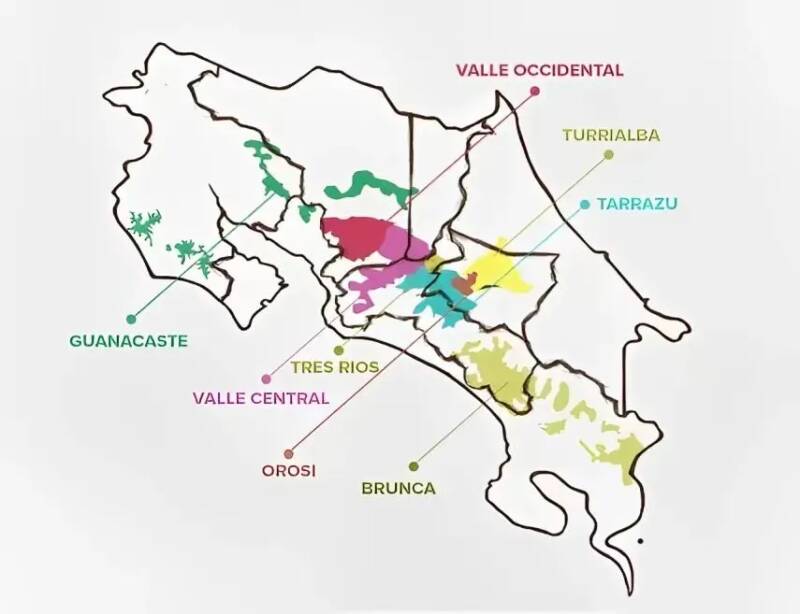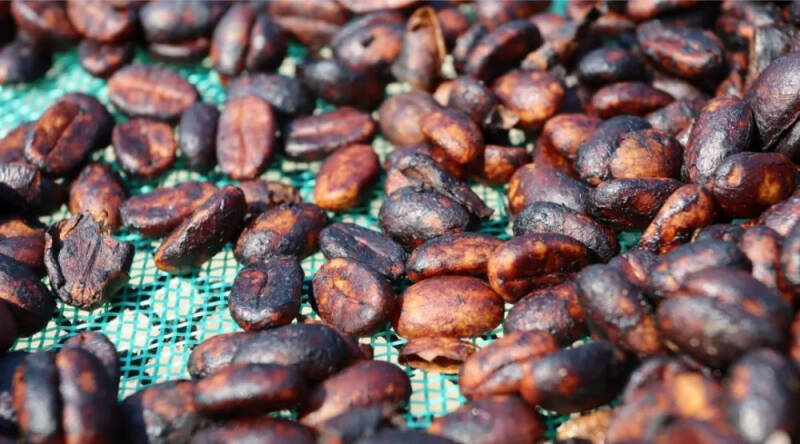Why is honey processing common in Costa Rica? How many kinds of honey treatments are there?
When it comes to sweeter coffee, many people think of Costa Rican coffee, because most Costa Rican coffee uses Honey Process, a coffee treatment between tanning and washing, which increases the sweetness and caramel taste of the coffee.
Honey treatment Honey Process, also known as Miel Proces, "honey" is from this "Miel", which means honey in Spanish. The earliest honey treatment came out in Costa Rica, and locals like to call the sticky pectin inside the fruit "Miel".
Although Costa Rica is the birthplace of honey treatment, the predecessor of honey treatment is the Brazilian half-sun treatment (Pulped Natural), which was originally invented to save water for production. Costa Rica draws lessons from this method, and the geography of Costa Rica has created the method of honey treatment.
During the period from 1997 to 2000, due to the low price of coffee in the international market, in order to earn more income to make ends meet, many farmers no longer sold their coffee fruits to large processing stations and began to sell their own coffee. As a result, when farmers mastered the way coffee was processed, they began to try more. At this time, half-sun in Brazil was introduced to Costa Rica with the characteristic of saving water for production.
In addition, central Costa Rica is run through by the Cordillera mountains, which brings many mountains, basins and volcanoes to Costa Rica, so the seven coffee producing areas in Costa Rica are in the mountains in the middle of the country, and coffee is grown between 1200 and 1650 meters above sea level. However, because the country is located in the Pacific Rim earthquake belt, earthquake-prone, in 2008, the country experienced a large earthquake.

The earthquake caused serious power outages and water shortages in many places, coupled with the fact that the country is mainly in high mountain areas, it is difficult to store water, it is also difficult to support water-consuming washing treatment, and it is not like African countries to have a longer period of sunshine, and there is also a greater risk of sun treatment, local farmers began to adopt this "water-saving" treatment method.
Although at first some people thought that this method of drying with pulp and pectin was easy to form uncontrollable fermentation, many farms got positive results after experiments, and greatly reduced the consumption of water resources. Later, through continuous improvement to form honey treatment, and also developed a variety of honey treatment methods to extend different flavors by controlling the fermentation degree of pectin.

After the coffee berries are harvested in the improved honey treatment, the peel remover is used to peel off the peel and part of the pectin of the coffee berries and then drip them out and spread them directly on a high drying rack to dry. By precisely controlling the thin thickness and drying time of pectin, black honey, red honey, yellow honey and white honey are subdivided.
Because pectin contains a lot of sugar, the raw beans that retain the pectin will oxidize when exposed to the air. The beans have the initial yellow-white appearance and turn golden. With the fermentation time, the beans may turn crimson or even black-purple, until the entire drying process is completed.
Red honey treatment will retain 80% of the pectin, the sun for 12 days, such a bean surface will be reddish brown. The pectin layer treated with yellow honey remains 40-60%. After about 8 days of sun exposure, the bean surface will be yellowish brown due to the thinning of the pectin layer. White honey retains less than 40% of the pectin layer, and the drying time is short, so the color of the beans is lighter. Black honey treatment is almost no removal of pectin, drying lasts for more than 14 days, so the bean surface will be dark purple.
At present, a novel and more complex treatment is also popular in Costa Rica, which is dried grape honey treatment (raisin honey). After the coffee berries are harvested, the all-red ripe fruit is floated, then it is laid out to dry directly, after the skin is wrinkled like raisins, the pulp is removed, and the pectin in the semi-dry state is kept to dry until the whole drying process is completed.
This treatment uses almost no water and retains 100% pectin to provide coffee beans with more sugar, showing the highest sweetness. However, this method is more demanding and has a high risk of deterioration, which requires more energy to take care of the raw coffee beans in the process.
In Qianjin Coffee, there is a strawberry candy from Mirazhu Manor in Tara Pearl, Costa Rica, which is treated with raisin honey and tasted with strawberry and raisin flavor in the mouth, with candy and nut flavor in the aftertaste. Creamy, honey-like taste.
For more information about coffee producing areas, please scan the code directly and follow: coffee comments.
Long press the QR code to follow:
TRANSLATE with
XEnglishArabicHebrewPolishBulgarianHindiPortugueseCatalanHmong DawRomanianChinese SimplifiedHungarianRussianChinese TraditionalIndonesianSlovakCzechItalianSlovenianDanishJapaneseSpanishDutchKlingonSwedishEnglishKoreanThaiEstonianLatvianTurkishFinnishLithuanianUkrainianFrenchMalayUrduGermanMalteseVietnameseGreekNorwegianWelshHaitian CreolePersian
TRANSLATE with
COPY THE URL BELOW
BackEMBED THE SNIPPET BELOW IN YOUR SITE Bing Webmaster PortalBack
Important Notice :
前街咖啡 FrontStreet Coffee has moved to new addredd:
FrontStreet Coffee Address: 315,Donghua East Road,GuangZhou
Tel:020 38364473
- Prev

Houthi armed forces implement a maritime blockade! Red Sea crisis continues in 2025
According to media reports, the British Maritime Trade Action Office said that Yemen's Houthi armed forces claimed responsibility for two attacks on merchant ships off the coast of Yemen on the 10th. One of the attacks caused damage but no casualties. According to Yahya Sareya, a spokesman for the Houthi armed forces in Yemen, the "Olympic Spirit" was "attacked.
- Next

Caught off guard! Mstand Quanzhou's first store is empty!
▲ Click to pay attention| Daily Boutique Coffee Culture Magazine Coffee Factory Recently, a Quanzhou user posted on social platforms saying that when he passed Jinjiang SM City Plaza the day before yesterday, he found that the Mstand gate on the first floor was closed, but there was no shop closure notice posted at the door. In this regard, people who went to stores to consume during the National Day
Related
- What effect does Italian American coffee with filter paper have? Will coffee taste better if it is put on filter paper at the bottom of the powder bowl?
- What is the color difference in coffee beans? What are the characteristics of honey processed coffee beans? Why are the anaerobically treated coffee beans uneven in color?
- How does novice Xiaobai quickly get started and make coffee? Newbies learn to make coffee by hand and share the specific steps and process process!
- Costa tea has a shelf life of 100 years?! Expert: Unable to verify
- It's a huge uproar! American milk addition was rejected by Manner employees?!
- Mocha pot coffee bean recommendations| How fine and how much powder should be used for grinding? What parameter ratios do I need to use to make milk with Mocha pot coffee?
- What are the characteristics of the world's top ten coffee beans treated with Costa Rica honey? How to make black honey kadura from Tarazhu Pilon Processing Plant taste good?
- How to make deep-roasted coffee? What grinding water temperature does authentic Jamaica Blue Mountain No. 1 coffee use to brew it well?
- Selected high-grade rose summer coffee flavor tasting guide Why Panama rose summer has the aroma of flowers and fruits
- What equipment does a novice Xiaobai need to buy to learn to make coffee? Filter cup electronic scale bean grinder manual flushing pot purchase guide

